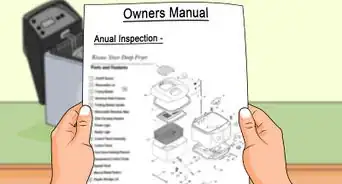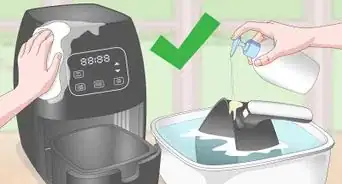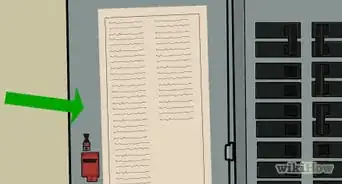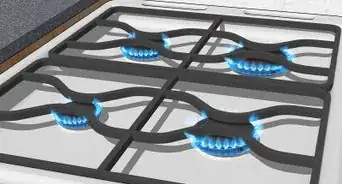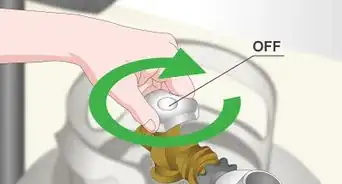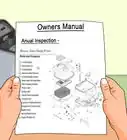wikiHow is a “wiki,” similar to Wikipedia, which means that many of our articles are co-written by multiple authors. To create this article, 12 people, some anonymous, worked to edit and improve it over time.
This article has been viewed 214,959 times.
Learn more...
A range hood is a very useful tool for minimizing smoke, steam, and odors produced when cooking. The hood is mounted above your cooktop, and has a fan that pulls air through ductwork and outside your home; non-ducted versions recirculate the air through a charcoal filter. While range hoods are usually not required at all by local building codes, cooking without one can lead to stagnating smoke and smells in your kitchen. The airflow capacity of a range hood is measured in CFM, or cubic feet per minute. For proper sizing, you will need to learn how to calculate CFM for range hoods.
Steps
-
1Size your range hood based on the heat output of your range. The first guideline for sizing a range hood depends on the output of your range as measured in British thermal units (BTUs). The recommendation by the Home Ventilating Institute (HVI) is to divide the BTU rating of your stove by 100 to arrive at a minimum guideline for CFM rating. So, a range that is capable of producing 35,000 BTUs should be paired with a range hood with a rating of 350 CFM or greater. This minimum guideline should be examined alongside other guidelines based on stove and kitchen size.
-
2Examine the relationship between your stove's size and the required range hood size. The HVI also provides recommendations for sizing a range hood based on the width of your range. If your stove sits against a wall, you should provide 100 CFM of airflow per linear foot of range.[1] For example, a 24-inch (60 cm) range would require a hood rated at 200 CFM or greater. If your stove is on an island, you should provide 150 CFM of ventilation per foot of your stove's length. So, a 24-inch (60 cm) range on an island needs 300 CFM of airflow.Advertisement
-
3Determine the recommended ventilation based on your kitchen's size. The HVI also recommends that your range hood should be capable of cycling the air in your kitchen completely 15 times per hour.[2] This equates to a complete cycling of air every 4 minutes.
- Begin by measuring the floor area of your kitchen. In a rectangular-shaped room, this can be done by multiplying the width and length. For example, a 10 ft x 15 ft (3 m x 4.5 m) kitchen has a floor area of 150 square feet (14 square meters).
- Calculate the total volume of your kitchen. This is done by multiplying the floor area by the ceiling height. For example, if a kitchen has 150 square feet (14 square meters) of floor area and a ceiling height of 8 feet (2.4 m), the total volume is 1200 cubic feet (34 cubic meters).
- Divide the total volume by 4 to get the required CFM rating. A kitchen with a volume of 1200 cubic feet (34 cubic meters) would need a range hood with a rating of (1200 / 4) or 300 CFM.
-
4Add more based on Ductwork. Once you've calculated your CFM based on the above points, you're also going to want to add 9 CFM for a 9' duct and 25 CFM for every elbow bend encountered.
-
5Choose the greatest of these 3 guidelines to size your range hood. After arriving at CFM recommendations based on heat output, range size, and kitchen size, compare the numbers. To ensure the best performance, size your range hood based on the highest number of the 3. Don't forget to add the value from Step 4! You just need to add it up to the highest of the other three.[3]
Community Q&A
-
QuestionHow do I convert cubic feet per minute to cubic meters per hour?
 Community Answer1 cubic meter/hour = 0.588 577 77 cubic feet/minute 1 cubic foot/minute = 1.699 010 82 cubic meter/hour
Community Answer1 cubic meter/hour = 0.588 577 77 cubic feet/minute 1 cubic foot/minute = 1.699 010 82 cubic meter/hour -
QuestionIs there a minimum building code standard for gas ranges?
 Community AnswerYes, most places require 100 CFM per 10,000 BTUs. Add all the BTUs in the range.
Community AnswerYes, most places require 100 CFM per 10,000 BTUs. Add all the BTUs in the range. -
QuestionIn Step One, is the number given per hour or per minute?
 Upnorth HereTop AnswererThe discussion in Step One is related to "cubic feet per minute", or "CFM". Step Three talks about "air changes per hour", or "ACH".
Upnorth HereTop AnswererThe discussion in Step One is related to "cubic feet per minute", or "CFM". Step Three talks about "air changes per hour", or "ACH".
Warnings
- Calculations are based on rule of thumb. If the manufacturer of your cooking appliance does not specify a range hood size in, then your hood should be designed by a professional ventilation engineer. R. Amos 3-24-2016⧼thumbs_response⧽
Things You'll Need
- Tape measure
- Calculator
- An Online CFM Calculator
References
- ↑ https://www.hvi.org/resources/publications/home-ventilation-guide-articles/how-much-ventilation-do-i-need/
- ↑ https://www.todayshomeowner.com/how-to-calculate-kitchen-range-hood-fan-size/
- ↑ https://www.todayshomeowner.com/how-to-calculate-kitchen-range-hood-fan-size/
- http://lib.store.yahoo.net/lib/rewilliams/ventilationfanguide.html







